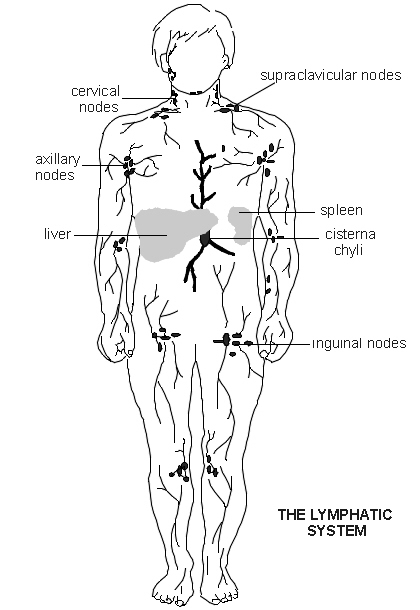
- Lymph
A clear, watery, sometimes faintly yellowish fluid derived from body tissues that contains white blood cells and circulates throughout the lymphatic system, returning to the venous bloodstream through the thoracic duct. Lymph acts to remove bacteria and certain proteins from the tissues, transport fat from the small intestine, and supply mature lymphocytes to the blood.
The lymphatic system and Hodgkin's disease
The lymphatic system is part of the body's immune system. It helps the body fight disease and infection. The lymphatic system includes a network of thin lymphatic vessels that branch, like blood vessels, into tissues throughout the body. Lymphatic vessels carry lymph, a colorless, watery fluid that contains infection-fighting cells called lymphocytes. Along this network of vessels are small organs called lymph nodes. Clusters of lymph nodes are found in the underarms, groin, neck, chest, and abdomen. Other parts of the lymphatic system are the spleen, thymus, tonsils, and bone marrow. Lymphatic tissue is also found in other parts of the body, including the stomach, intestines, and skin.
Hodgkin Disease
A rare type of cancer characterized by painless enlargement of the lymph nodes, lymphatic tissue, and spleen, with subsequent spread to other areas. Fever is a common symptom of Hodgkin's disease and weight loss, anemia, loss of appetite, and night sweats may occur. The condition is named after the pathologist Thomas Hodgkin (1798-1866), who first described it. Hodgkin's disease is much more common in men. Treatment varies with the stage reached by the disease but in general consists of radiotherapy, surgery, chemotherapy, or a combination of these. Caught in the early stages it is potentially curable.
Hodgkin's disease is one of a group of cancers called lymphomas. Lymphoma is a general term for cancers that develop in the lymphatic system. Hodgkin's disease, an uncommon lymphoma, accounts for less than 1 percent of all cases of cancer in this country. Other cancers of the lymphatic system are called non-Hodgkin's lymphomas.
Cancer is a group of many related diseases that begin in cells, the body's basic unit of life. To understand Hodgkin's disease, it is helpful to know about normal cells and what happens when they become cancerous. The body is made up of many types of cells. Normally, cells grow and divide to produce more cells only when the body needs them. This orderly process helps keep the body healthy. Sometimes cells keep dividing when new cells are not needed, creating a mass of extra tissue. This mass is called a growth or tumor. Tumors can be either benign (not cancerous) or malignant (cancerous).
In Hodgkin's disease, cells in the lymphatic system become abnormal. They divide too rapidly and grow without any order or control. Because lymphatic tissue is present in many parts of the body, Hodgkin's disease can start almost anywhere. Hodgkin's disease may occur in a single lymph node, a group of lymph nodes, or, sometimes, in other parts of the lymphatic system such as the bone marrow and spleen. This type of cancer tends to spread in a fairly orderly way from one group of lymph nodes to the next group. For example, Hodgkin's disease that arises in the lymph nodes in the neck spreads first to the nodes above the collarbones, and then to the lymph nodes under the arms and within the chest. Eventually, it can spread to almost any other part of the body. 
 Lymphatic system
Lymphatic system

